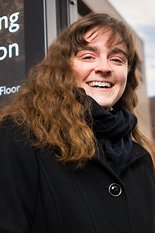Assistant Professor Christine Hartzell’s Research Will Help Develop Better Vehicles for Space Exploration
February 27, 2017
Generations of women have contributed to engineering, and Clark School women are proud to be part of that tradition. In honor of women’s history month, the Clark School is celebrating one female engineering faculty member each day. Read about today’s featured faculty member, Christine Hartzell.
Aerospace Engineering Assistant Professor Christine Hartzell has been fascinated with space since a 4th grade science project first introduced her to the universe beyond earth. Since then, Hartzell has propelled herself to an academic career exploring the complexities of asteroid dust and the interactions of materials on airless bodies such as the moon, and her research could affect the future of spacecraft design to make what is now science fiction into science fact.
Hartzell studies the complex nature of regolith—the dirt and dust on moons and asteroids—and develops computer models to simulate the interactions between multiple grains and how the material behaves under different conditions.
“Asteroids and the moon don’t really have an atmosphere, so the surface interacts directly with the solar wind plasma,” explained Hartzell. “That interaction with the plasma creates a region above the surface [of the asteroid] called a plasma sheath.”
This plasma sheath, Hartzell said, can create an upward pointing force above the surface of an asteroid that is like the static electricity that we experience on Earth. This force can pull the dust up from the asteroid’s surface—a phenomenon known as electrostatic dust levitation.
Hartzell has an asteroid named in her honor, “9319 Hartzell.” The asteroid is part of the main asteroid belt located between the orbits of planets Mars and Jupiter.
“Regolith is very cohesive, like baking flour,” said Hartzell. “I assumed that all of the grains were spheres, which they are not. They’re very angular and pointy, because there is no water on the moon to smooth them out.”
By modeling dust on the surface, and interactions of multiple grains, Hartzell can study natural features like avalanches on asteroids or the moon, or she can design better sample selection devices, robotic wheels or other parts of the spacecraft that interact with the surface.
She is currently a member of the Strata-1 Team, a group of scientists from across the U.S., who developed a project, now aboard the International Space Station, to investigate the effects of micro-accelerations on this regolith.
Better understanding of how the surface materials of asteroids and other airless bodies behave is critical to the future development of spacecraft and spacesuits, and contributes to the Asteroid Redirect Mission (ARM), an integral part of NASA’s Journey to Mars.










